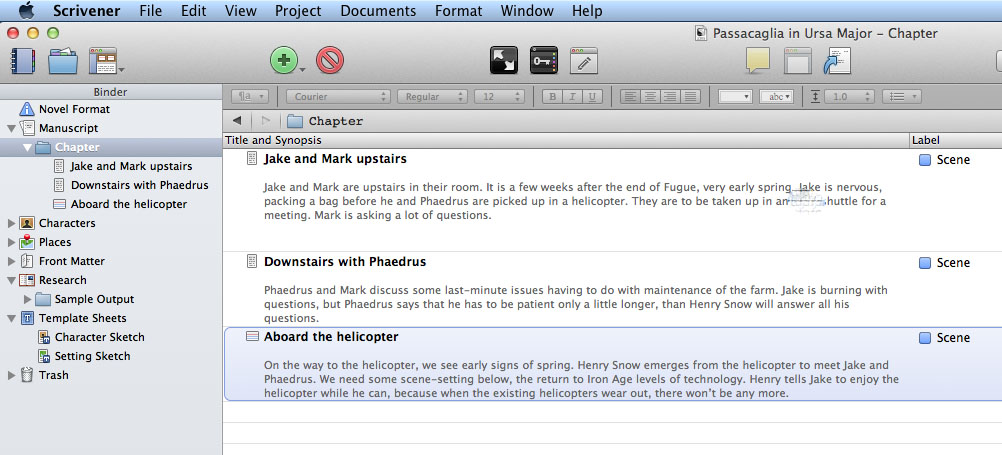Scrivener is an application particularly designed for writers. It has templates for fiction, non-fiction, academic work with footnotes, screenplays, etc. It is available for Macintosh, Windows and Linux.
I’m a nerd. I have been using Macintoshes since the 1980s. I use Adobe InDesign for publishing work, and I’m very happy with it. But InDesign isn’t for writing; it’s for setting up typography and page layout in the final steps of publishing. As I prepare to write the sequel to Fugue in Ursa Major (which has the working title Passacaglia in Ursa Major), I simply could not face writing another novel in any of the editors I’ve ever used. I’ve used many editors. I go all the way back to vi and nroff in the early Unix world. Like I said, I’m a nerd.
I started looking for outliners and editors. They all are terrible. I like many of the concepts of programs like BBEdit, because they’re clever and oriented toward streams rather than pages. But BBEdit and other programmer’s editors don’t even support bold and italics, as far as I could tell. I despise Microsoft Word and refuse to use it. I cannot stand software that tries to automate things and that thinks it knows better than I do. In Word, things are always hopping around in unpredictable ways. For every keystroke that Word’s automated features might save you, 9,462 keystrokes are required to clean up the messes it makes. LibreOffice is no better, just because it’s from the Word universe. The chief virtue of LibreOffice is that it’s fully Word compatible, so that one doesn’t have to support Microsoft.
Opting for simplicity and nonviolence, I was about to start the new novel in Macintosh TextEdit, using a TextEdit file as an outline. TextEdit is a simple, bare-bones editor. But then while Googling I came across Scrivener. I could scarcely believe it. There are people on the planet who think like me!
Scrivener is complicated, but that’s fine. I think I’ve figured out an acceptable way to set up the new novel. Scrivener’s corkboard metaphor for outlining threw me a bit, but I think I’m getting a grip on how to set up my outline using a table view of the outline (pictured above). I think I would buy this program for typewriter mode alone. Typewriter mode keeps the cursor at the center of the text block, so that you can always see the context above and below what you’re writing or editing. It drives me absolutely crazy to always be typing at the bottom of the screen. Also, I abhor being forced to type on images of 8.5×11 pages and watching text hop from page to page and get entangled in unneeded and unwanted headers. A novel has nothing to do with pages until the last steps of the publishing process, in InDesign. During the writing process, it’s just a stream of text, and putting the text on pages just gets in the way.
I wrote Fugue in Ursa Major chapter to chapter, but I had already decided that I wanted to structure the new novel as scenes. Scrivener was ahead of me on that. By default, chapters are made up of a sequence of scenes. I also wanted a way to track settings and characters. Scrivener was ahead of me on that. It has templates for tracking characters and scenes, and the text can be tagged if you need to search a long novel for places that involve a particular character or scene.
The concept of compiling is brilliant. Having used software compilers for 30 years, it was instantly clear to me how the concept of compiling is appropriate to a long stream of text. Scrivener’s compile feature will probably scare users who are unfamiliar with the concept. But if you go through the tutorial that comes with Scrivener, compiling will start to make sense.
Scrivener costs $45 for a single-user license. The software was written by a nerd in Truro, Cornwall, because he needed a program like Scrivener to help him write his Ph.D. dissertation.

Post a Comment